Art Fairs
8 Irresistibly Elegant Booths at the 2018 Independent Art Fair
From pie graphs to itty-bitty handball courts, here are our highlights from the Tribeca-based fair.

From pie graphs to itty-bitty handball courts, here are our highlights from the Tribeca-based fair.

Henri Neuendorf &
Tim Schneider

The blizzard that descended on New York 24 hours earlier had cleared out by the time that Independent, the Armory Show’s slightly more refined cousin, opened to VIPs on Thursday. It looked like any out-of-towners delayed by the winter storm the day prior had no trouble following the next phase of their itinerary. Miami collectors Don and Mera Rubell were on the scene, as was Belgian financier and art world pundit Alain Servais. Meanwhile tireless New Yorkers, including collectors Susan and Michael Hort and critic Jerry Saltz, were in attendance, too. And if the sight of Maurizio Cattelan working his way through the crowd didn’t provide enough star power, there was even the (unconfirmed) rumor of a Jay Z and Beyoncé sighting.
The term “curated” tends to be tossed around more than a little too liberally in art fair press releases these days, but Independent actually does pay close attention to its presentation—and the effort shows. The booths have a certain congruence that owes to exhibitors being arranged based on factors such as medium, content, even color scheme. In an environment with so much cohesion and thought, it can be difficult to single out a few top booths. Nevertheless, a small number did stand out. Here are our picks.
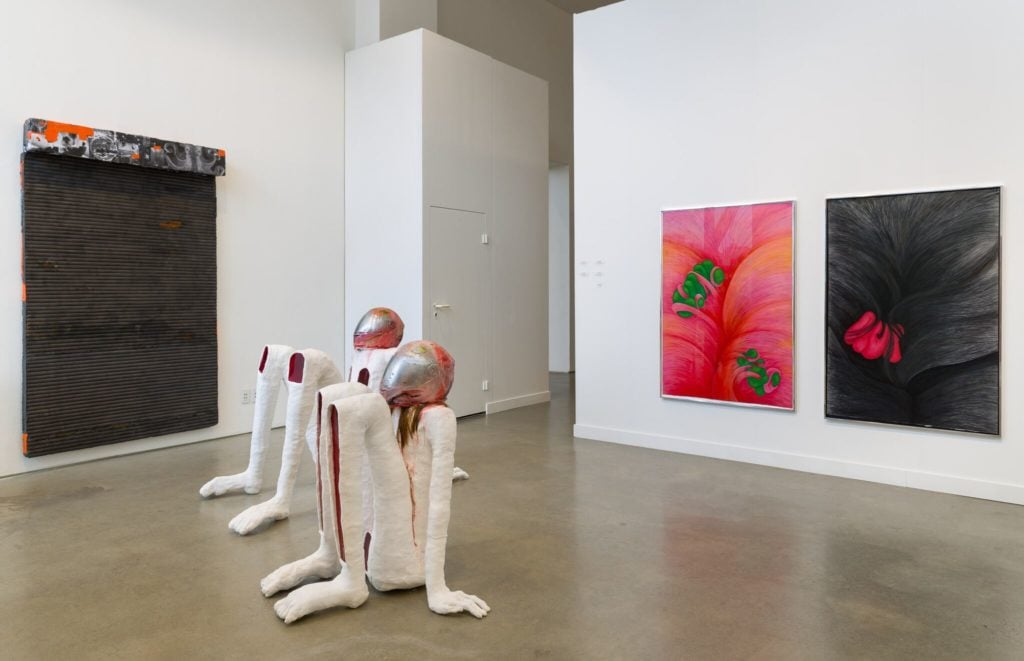
Rebecca Ackroyd at Peres Projects, Berlin. Photo: Etienne Frossard, courtesy Independent.
Peres Projects showed a solo presentation of new works by 31-year-old British artist Rebecca Ackroyd. Working in a variety of different materials, the gallery brought pastel drawings, wall reliefs, and floor sculptures. With the artist fresh from an exhibition at the Zabludowicz Foundation in London, it was Ackroyd’s first presentation of work in New York. Gallery partner Nick Koenigsknecht told artnet News that the multidisciplinary artist will be the subject of a solo show during Berlin’s popular gallery weekend in April.
“We’re showing the full spectrum of the wide variety of her work which encompasses drawings, wire and paper mâché, and cast-iron metal sculpture,” he explained. “Her diverse use of material represents the divergent nature of our modern existence where we are connected more closely than ever by technology but are simultaneously growing apart.”
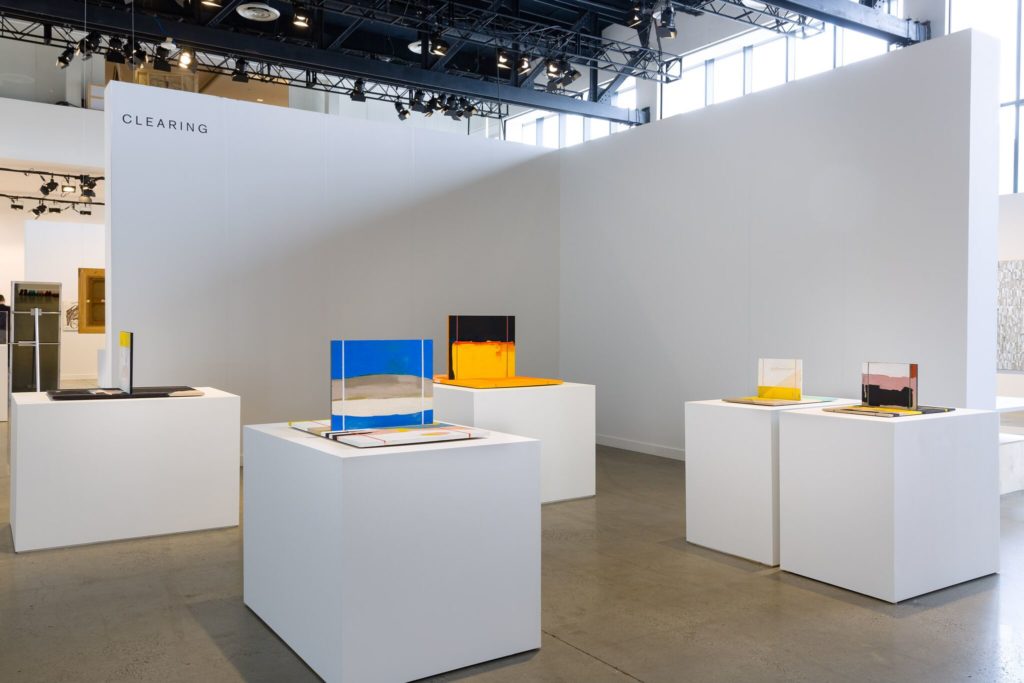
Harold Ancart at CLEARING, New York/Brussels. Photo: Etienne Frossard, courtesy Independent.
A large crowd was gathered around CLEARING‘s booth, which was showing Harold Ancart‘s new sculptural works, first presented at their Brooklyn gallery in September. Dealer Olivier Babin told artnet News that this exciting new direction of the uber-hot artist, who is primarily known as a painter, has attracted a great deal of attention from collectors (although he declined to divulge how much interest the work was generating in terms of sales).
“What’s new about the work is that Harold is engaging in sculpture and architecture for the first time,” Babin said of the wood sculptures, which allude to urbanism and the built environment due to their resemblance to hand-ball courts. “He’s exploring the intersection of painting and sculpture,” the dealer explained.
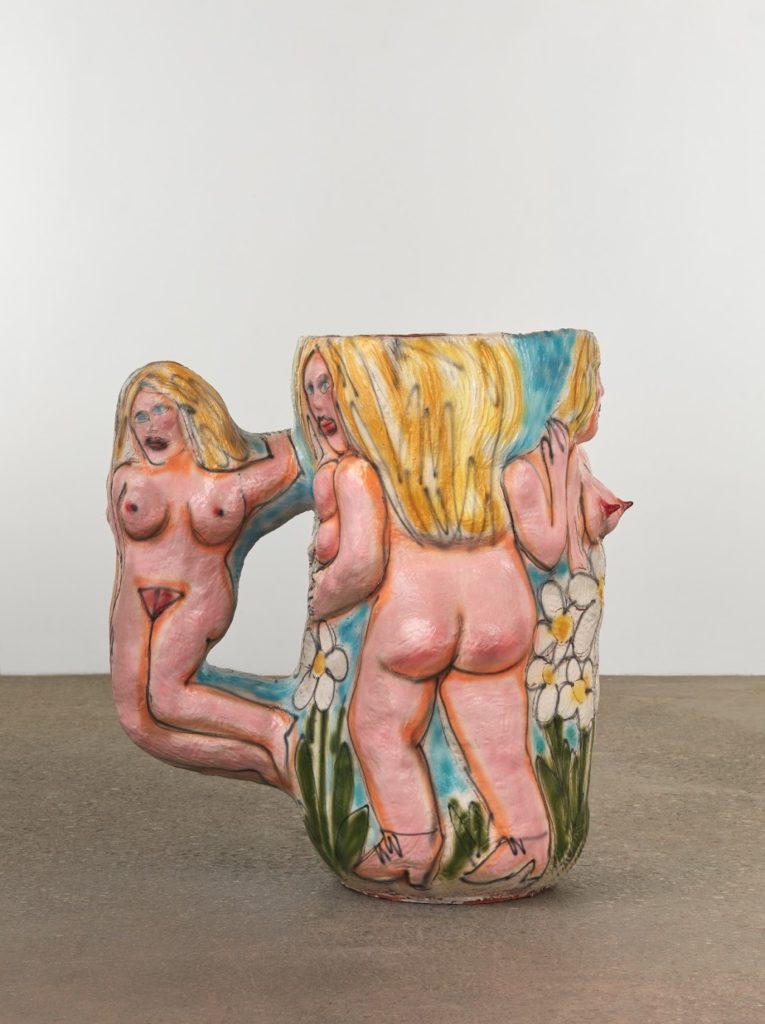
Ruby Neri at David Kordansky Gallery. Photo: Etienne Frossard, courtesy Independent.
Showing an array of eye-catching pots and sculptures adorned by nude female figures, David Kordansky‘s presentation of works by the feminist ceramicist Ruby Neri was among the most apt presentations, given that the opening of Independent coincided with International Women’s Day. Speaking to artnet News, director Mike Homer explained that the Californian artist started her career as a member of the Bay Area Mission School, a group of graffiti artists that included fellow San Francisco native Barry McGee. In the mid-’90s she moved to Los Angeles to study at UCLA under Mike Kelley and Paul McCarthy. As a result, her practice is an amalgamation of Bay Area folk and LA body-focused art.
“It’s the biggest-ever solo presentation of her work in New York City and people love it,” Homer said, adding that they sold all except one of the works priced between $15,000—$35,000. “People really respond to it because it’s fucking fearless,” he exclaimed.
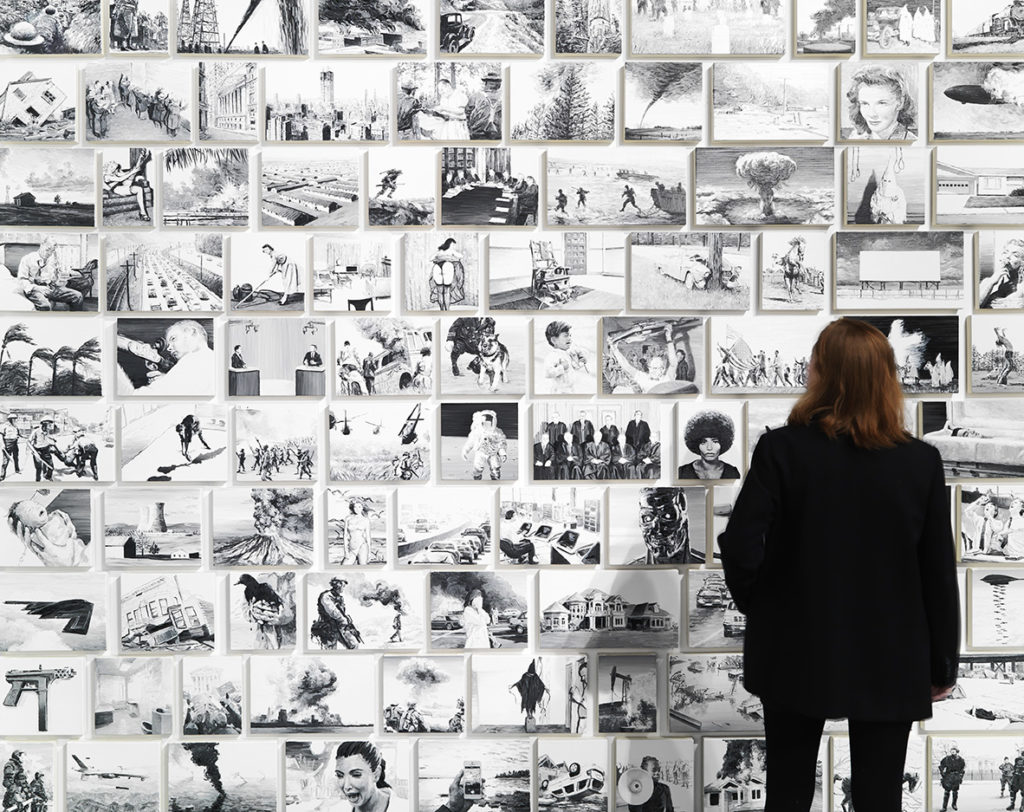
Cynthia Diagnault, What Happened (2018). Photo: courtesy of the Sunday Painter, London.
Making the trip to New York from London, The Sunday Painter gallery stood out with a large 100-piece artwork by American artist Cynthia Daignault, which covered an entire wall of their booth. Titled What Happened, after Hillary Clinton’s book about loosing the 2016 American presidential election, every gray-scale painted panel represents once year of the past 100 years, starting with World War I. Director Will Jarvis told artnet News that the work is “about shared experience and about disillusionment with the state of civilization.
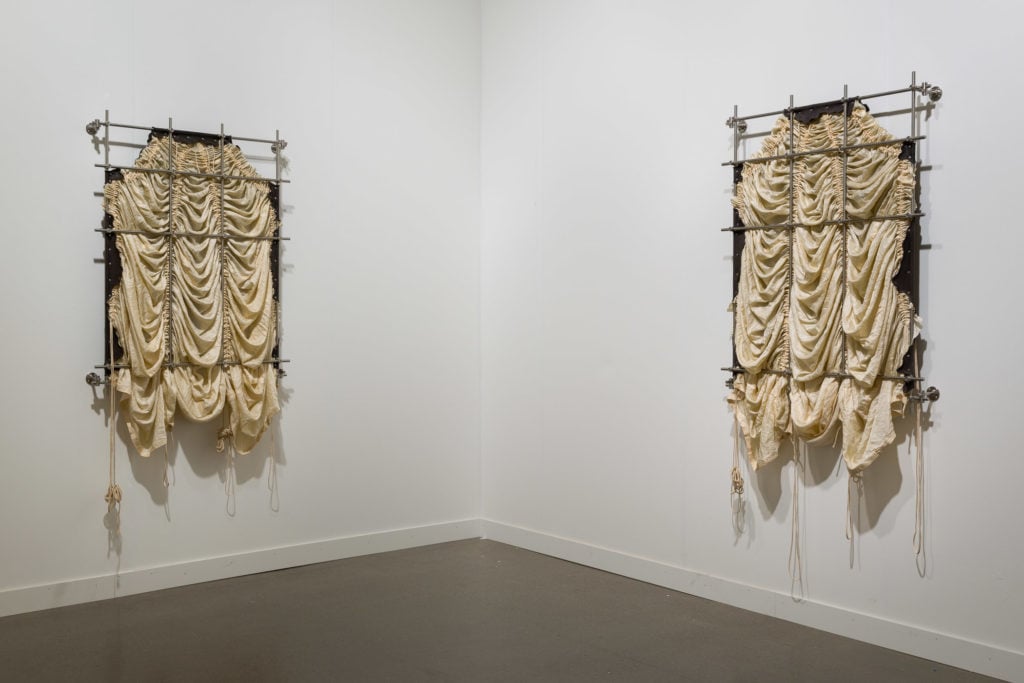
Elaine Cameron-Weir works in JTT’s booth. Photography by Etienne Frossard. Courtesy Independent.
The Soho favorite took a less-is-more approach at this year’s Independent, and it pays off. The booth offers just three works: two by rising-star Elaine Cameron-Weir (who will debut a site-specific installation at Storm King in May), and one by Borna Sammak, who will be the subject of the gallery’s next exhibition. While the artists are close friends and fellow NYU alumni, the real kinship between Cameron-Weir and Sammak is in their savvy manipulation of tactile materials. The works on view here expose, or perhaps even parody, some of the structural fundamentals of painting—right-angled armatures, stretched cloth, mounting hardware. As a result, they provide a breath of fresh air in a canvas-saturated fair week.
Cameron-Weir’s wall installations seem to trap Victorian lingerie (parachute fabric, it turns out) inside an S&M gurney, with the would-be “canvas” sagging uselessly toward the floor through its metal supports. Sammak’s piece, an assemblage of beach towels over partially exposed stretcher bars, evokes thoughts of a Roy Lichtenstein brushstroke canvas after a shark attack.
All three works manage to transgress convention with a wink, which may be why collectors responded swiftly. The $20,000-30,000 works were all on hold by the time artnet News visited the booth at mid-day.
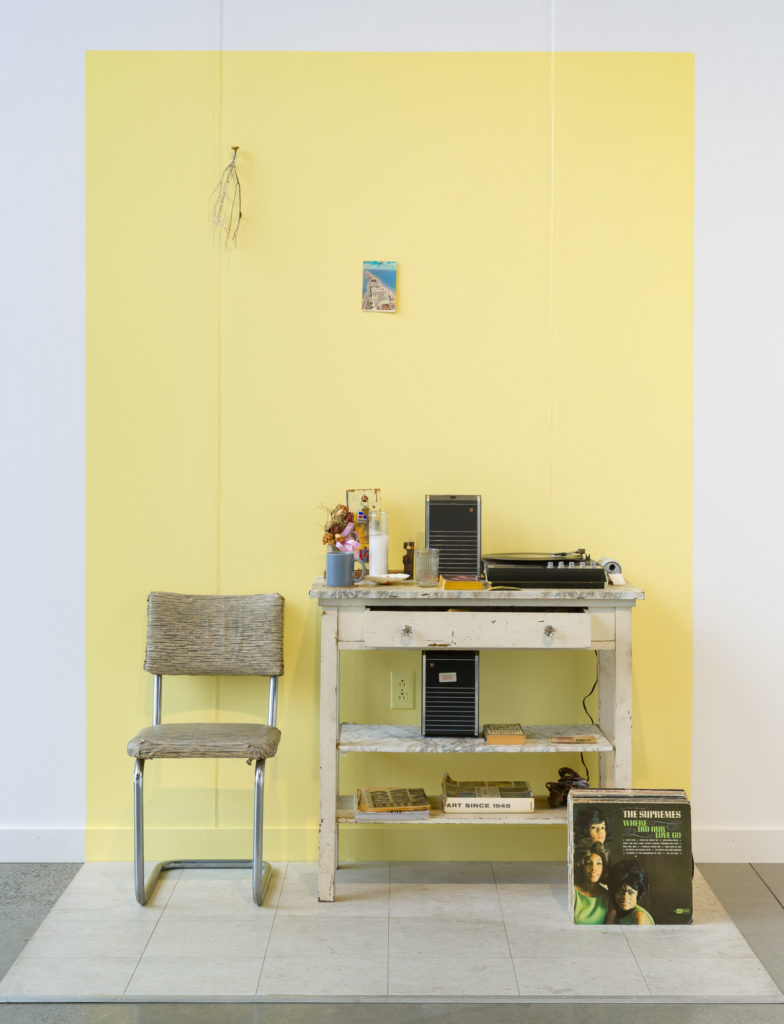
Jack Pierson installation at Cheim & Read’s booth. Elaine Cameron-Weir in JTT’s booth. Photography by Etienne Frossard. Courtesy Independent.
For this year’s edition of the Independent, the Chelsea stalwart devoted itself to a thoughtful selection of historical works by multidisciplinary artist Jack Pierson. Each piece on view hailed from either the early 1980s or early 1990s, two periods that Cheim & Read‘s Francesco Longenecker defined as “pivotal points… which sent him in the direction” leading to his best-known works. Split almost evenly between available works and private loans, the booth is highlighted by Pierson’s first word-sculpture and a domestic assemblage, exhibited at both the Denver Art Museum and the 1993 Whitney Biennial.
According to Longenecker, the latter piece represents the artist’s answer to the question, “If you could go anywhere, where would you go?” Pierson decided he would travel back in time, to a room in Miami Beach where foundational thoughts on his work crystallized during a vacation from teaching at Cooper Union. Although Pierson was able to faithfully reproduce a part of that setting through a combination of original objects and replacements, his point is that the installation remains fundamentally incapable of recapturing the lost moment.
Like almost all of Pierson’s work, it viscerally tackles the power of place, the limits of memory, and the universality of nostalgia. The few available works on view ranged from $35,000 to $150,000.

Cary Leibowitz at Invisible Exports. Photo by Etienne Frossard, courtesy Independent.
The beloved writer-director Joss Whedon once offered this nugget of wisdom to his peers on their work: “Make it dark, make it grim, make it tough, but then, for the love of God, tell a joke.” Multidisciplinary artist Cary Leibowitz may work in a different field, but he’s spiritually aligned with Whedon’s point of view. Currently the subject of a retrospective at Philadelphia’s Institute of Contemporary Arts, the artist filled this solo booth full of colorful pie-chart paintings and familiar white-porcelain objects, each scrawled with admissions of self-deprecating angst that most of us spend our lives struggling to contain within our inner monologues. Consider, for example, a flower vase displaying the repeated phrase, “Don’t be a crazy person,” or a pie-chart with four slices reading, in succession, “fuck,” “fuck,” “fuck,” and (largest of all) “i’m sorry.”
Although Leibowitz initiated the two bodies of work in the 1990s, Risa Needleman, the gallery’s co-owner, explained that the artist left both dormant for roughly two decades before revisiting them recently. While she said she would have to defer to Leibowitz on why he chose to return to the subject matter now, the work is entertaining and poignant enough that the answer could just as well be nothing, everything, or any point between. Prices range from $1,500 to $20,000.
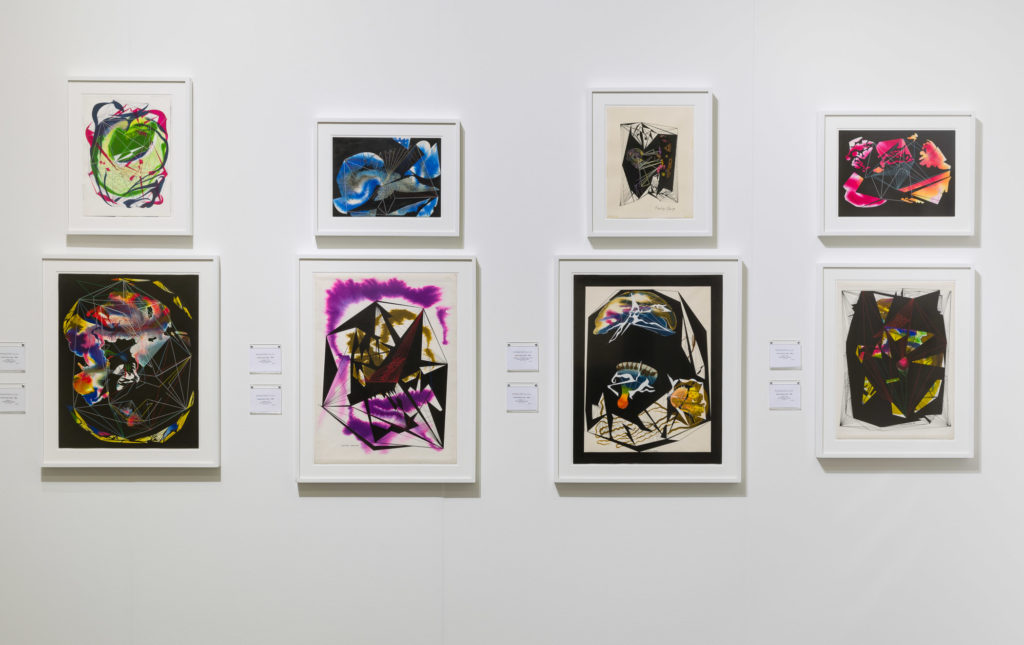
Paulina Peavy works in Andrew Edlin’s booth. Photography by Etienne Frossard. Courtesy Independent.
Although a bewitching Terence Koh installation forms the booth’s gravitational center, the true discovery occupies one of the flanking walls. There, adjacent to a selection of small “talisman” works by Melvin Way, visitors can absorb several mixed-media pieces by Paulina Peavy. Born in 1901, Peavy’s unique trajectory took her from studying at the Chouinard School of Fine Art (now CalArts) to painting murals alongside Diego Rivera at the 1939 Golden Gate International Exposition. But each of the works on offer by Edlin arise from a more esoteric vocabulary—one that seems to hybridize the work of a constellation chartist with a shaman.
Background on Peavy’s later life helps bring the imagery’s source into focus. According to gallery director Phillip Jones, the artist claimed that her cosmic abstractions were “collaborations” with a UFO known as Lacamo, which she connected with in part by donning decorative masks of her own creation. Even more interesting in our current climate, she also prophesied that mankind would soon transcend gender, sexual reproduction, and arguably all other traditional binaries—an idea she manifested in even the smallest ways, such as signing her works in multiple directions so their owners could hang them in any orientation they chose.
So while the works themselves are timeless, the concepts that defined their maker are almost eerily timely. Jones declined to comment on availability or pricing per gallery policy. If you want to find out more, you’ll have to provide a more powerful lure than possible press coverage.